
|   |

|   |
 e-mail: leelakaverivenkat@gmail.com In memory of a Kathak legend Photos courtesy: Kathak Darpan May 22, 2023 The two-day Kathak Darpan organised Smriti Festival, paying homage to late Pandit Birju Maharaj, held at the Madras Music Academy, while mentioning, in the printed information in dailies, 3 Padma Shri awardees and 5 Sangeet Natak Akademi awardees as participants, listed no names. Mounted with laudable effort, not to speak of a large heart, by Kathak Darpan Institute of Chennai run by Kathak dancer Neha Banerjee, a student of Pandit Birju Maharaj, it is surprising that the organiser seemed totally unaware about Chennai audiences - for whom late night soirees of the kind held in the North till the wee hours of the morning, are out of bounds - and no cultural programme in Sabhas lasts beyond 8.30pm. To plan evenings with the best of fare programmed after 9pm was, to say the least, being over optimistic. The carefully crafted, varied, two-day event, comprising distinguished senior performers, even for the opening evening's presentation held in the mini auditorium, elicited a very modest gathering - though graced by the Consul General of Thailand Nitrooge Phoneprasert as chief guest, with those present including Mr Sundaram of Cleveland fame, along with Kathak scholar Puru Dadheech (whose Kathak training was under Jaipur gharana stalwarts), along with his wife Dr. Vibha Dadheech, Maharaji's top shishya Saswati Sen now looking after Kalashram Institute of Dance, Music and Fine Arts started by the Maharaj, and last but not least, featuring members of Pandit Birju Maharaj's family as performers - daughter Mamata Maharaj, son Deepak Maharaj, and grand-daughter Ragini. It was sad to see the massive main auditorium on the second evening, with just a smattering of people. While Kathak has never been a big draw for Chennai audiences, for an artist of the stature of Maharaji, who had, on several occasions held Sabha audiences in this city spellbound with performances and lecture demonstrations, art lovers, one felt, would have responded more generously. 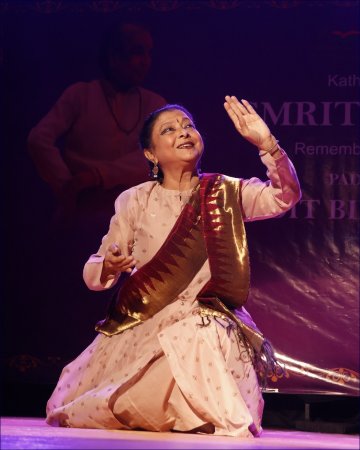 Saswati Sen Saswati Sen, obviously deeply moved by the occasion, after a pithy introduction pointing to the 'giving nature of Maharaji as a Kathak guru', and his versatility as musician, percussionist, instrumentalist, painter and poet, presented Madhurashtakam with Maharaji's own singing voice on the tape, making his presence palpable - even as the performer's mobile face expressed Krishna as the embodiment of charm in every aspect. As one of the seniormost among Birju Maharaj's disciples, training and imbibing from him over a lifetime career of fifty one years, Saswati's curtain-raiser for the next evening comprised an item written, composed and choreographed by the master in the devotional vein. Built round Krishna in Brindavan "Jaki mahima he..." wherein the butter stealer, the charmer with Radha, and Krishna who comes to the rescue of his devotees like Draupadi, are all glimpsed at, with Saswati's expressional subtlety at its best. 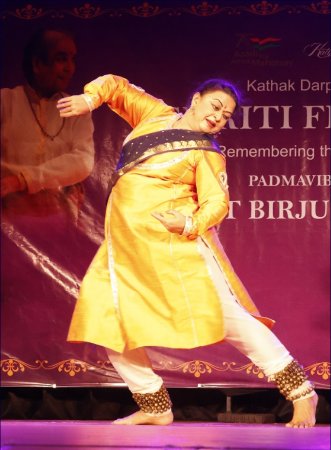 Mamata Maharaj Mamata Maharaj's short presentation on the opening evening, built round taal dhamar, in each of the nritta ad-forms, caught Maharaji's sense of aesthetics in the way bols are placed - even in a Ginti tihai where numbers in an ascending order of 1 to 7 (twice that number would be the Dhamar tala count) radiate an artistry through just the spacing. Only using the language of numbers, even without bols, the master could create poetry. 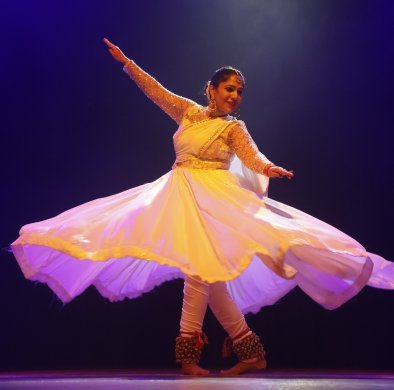 Neha Banerjee 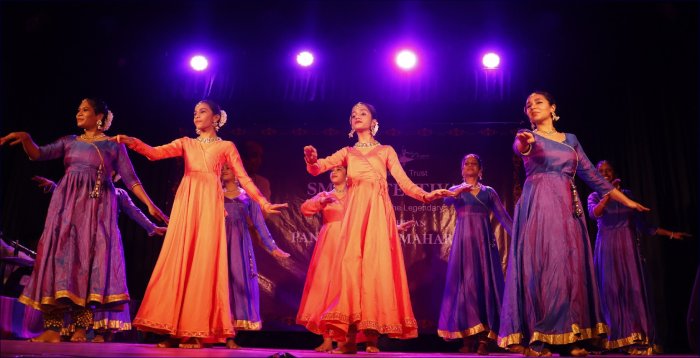 Kathak Darpan Apart from hosting such a high profile presentation, dancers of Kathak Darpan Trust along with Neha Banerjee presented Angikam Bhuvanam, the live music accompaniment having Vivek Misra (tabla), Somnath Mishra (vocal), Bholanath Misra (tabla), Dhruvanath Misra (sitar) and Omkar Agnihotri on keyboard. For such a traditional programme, one wonders about the inclusion of the keyboard, which now has become a part of Kathak fare. It has its place in fusion music, but adding an electronic element for me, brings in an alien tone. After the Angikam Bhuvanam slokam, wherein Shiva is worshipped as the very embodiment of the dancing cosmos, with the universe as his body, the stars and the moon as his adornments - and his song and poetry forming the essence of all speech, the students presented Kathak teental. Very aesthetically costumed in white, Neha Banerjee took over in a solo presentation - her Amad, Paran Amad, Chakradhar Paran and peir ka kaam and upaj very neat. Neither ang nor virtuosity of pure dance could be faulted. 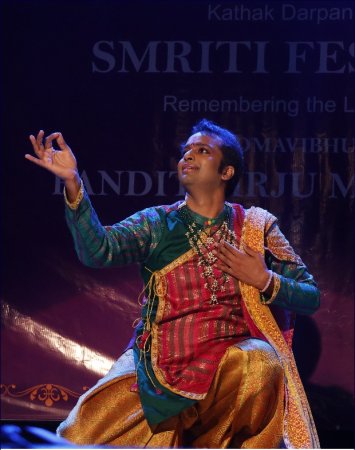 Sunil Sunkara Sunil Sunkara, combining both academic understanding (studied under Puru Dhadheech) and dance expertise (trained for several years in Chicago as Natalia's student before coming under Birju Maharaj and joining Kalashram in 2009), spoke of how, for him, Maharaji as Krishna, had always represented his ideal of how one visualised the image of this God in dance. He recaptured the master meditating, with closed eyes, and having a sip of water - and then, while dancing "Birju Maharaj transformed into Brij Shyam", is how he put it. He still recollected the master's presentation of Udhav Samvad. Sunil's presentation of Shyam murat man bhayo, given his fine stage presence and involved rendition, caught varied images of Krishna, as the charmer of the gopis, the beloved of Meera, the saviour of Draupadi's honour and as Hari who is "Jan ki peer". The next evening, resplendently turned out, to impersonate a royal personality, the dancer switched over to the histrionics of Anubhoothi, woven round Maharaj Bhojraj of Chittor, the wedded spouse of Meera. Notwithstanding the Raja's yearning for Meera, he was destined to acknowledge the fact of her having given her heart already to Krishna. The moving music composition was by Kartik Raman. In his introduction, Sunil traced a connection to the concept, of sacred interchangeability in divine energy, as conceived in Indian mythology - a well-known example of which is the Krishna Kali concept prevalent in Bengal - the same divine energy being conceived in changed incarnations - representing Krishna on the one hand and Goddess Kali on the other. Deeply in love, Bhojraj as an ardent devotee of Kali (the Goddess being equated to Krishna) reflecting on Meera's intense spirituality, imagines in her, the entwined divinity of both Kali and Krishna. But his tragic cry at the end is "Meera, Krishna ko dekha, mujhe nahi dekhaya" (you saw Krishna in Kali, but did not show him to me). Script, music, not to speak of Kavits woven into the danced expression made for fine communication, well received by the audience. The performance by Kalashram students was delightful and chiming with the occasion, rightfully, based on Birju Maharaj's own compositions. I still recollect, how when first presented by the Kathak Kendra in one of their main festivals, Ghungroo Sangeet, based on Raga Bhopali, wherein the sa re ga pa dha sa notes of the raga, representing the six notes - expressed through ankle bells clad feet, had brought the house down in applause. But one recollects ankle bells being of varying sizes (some even like those slung round the cattle's neck), with greater tonal variety, bringing out the quality of each note, apart from its placing in the microtonal alignment of arohan /avarohan. What was now visualised, one felt, was slightly different, perhaps because bells of really large sizes are not easily available. For the music comprising pure solfa syllabic passages, expressed through the footwork with minimal hand movements, with six pairs of anklets (with minimal variations) worn by the dancers, despite shortcomings, made for very melodious fare, with the item impeccably rehearsed. 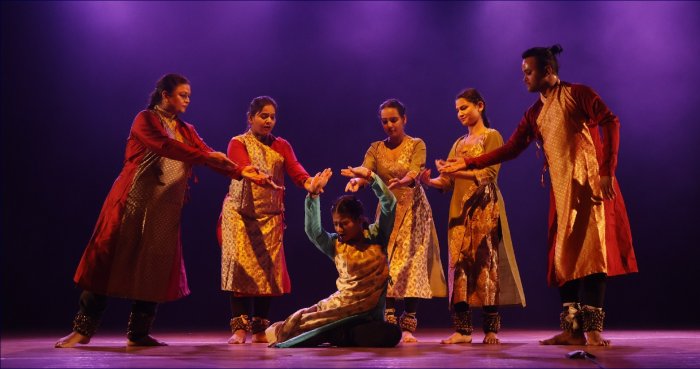 Kalashram students On the second evening Kalashram presented Naad Gunjan, another of the very imaginative compositions of Birju Maharaj based on a variety of percussion instruments which he delighted in playing and experimenting with, whenever he was not engaged in teaching. This item was an example of how Maharaji's fascination for the micro features of sound comprising the tonal quality of each syllable played on these percussion instruments, (depending on which part of the instrument is struck) creating varied aural music. Sometimes two varied sounds joined together to form another syllable and bol. These sounds when grouped together, apart from creating a language of sounds, add up to the power of also communicating emotions. As the taped percussion ensemble played on, each instrument was represented by one dancer dancing to the syllables played, and it was important to use only that part of the foot or feet to tap the ground to imitate the sound of the syllable emerging (like tapping floor with a full flat foot, or with just heels, or just the front part with the toes of the feet, or even just the sides - all creating different types of sounds). Naad Gunjan saw Mamata Maharaj representing tabla badya (melodic side of the tabla), Shanky Singh standing for the nagada, Yukti Jain for daff, Himanshi Gohini for naal, Sneh Kumar Ujjwal for pakhawaj and Moumita Ghosh for manjira. And the most enjoyable part was seeing the percussion syllables coming together to orchestrate pleasure, surprise, anger, wonderment and what have you - all of which became part of the dialogue, as the percussion ensemble played on the recorded backdrop of tala vadya music. Clearly, one of the most enjoyed programmes and one saw how words were not needed to convey an idea or feeling. Among students of Birju Maharaj, one of the solo dancers of the festival who stood out was Nidhi Prabhu, being witnessed by Chennai audiences for the first time. Taut-bodied, clean movements reflecting the very epitome of springy grace, her presentation in Jhaptal radiated that quality where even in a minimalist movement or stillness of a gesture or posture, one had the feel of its being a punctuation in a longer movement statement running through and stated by the entire body. It is this quality of musicality of the entire body while one moves, which Maharaji had, and which some students seem to reflect more fully. The chalan, the clarity of footwork, the freezing, chakkars, Ginti ki tihai, though in limited portions, had a quality of poetry. HOMAGE OF NON-KATHAK ARTISTES Inviting non Kathak artistes also to participate in this tribute was a good idea, their joyful acceptance underlining the regard for Maharaji's place in the art world as one who put Kathak prominently on the world map. 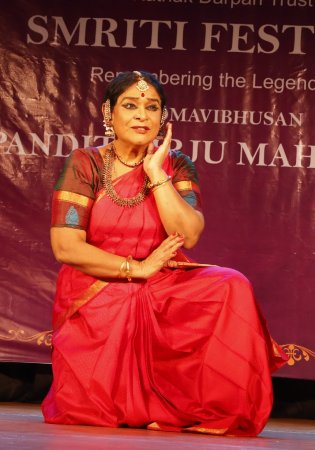 Bragha Bessell Gracing the mini hall was Bragha Bessell, one of the most accomplished abhinaya performers in Bharatanatyam. Starting with awe and admiration for all the nine states-of-being or moods - the Navarasas - reflected on the persona of Shiva with his accoutrements, the dancer went on to Natha Hare, the ashtapadi from the Gita Govind, wherein the sakhi, describing to Krishna the pitiful condition of Radha pining away for him in her home (vasa grihe), implores the lord not to tarry any longer and go to her forthwith. With singer Hariprasad's deeply moving singing what he himself set to music in raga Vasanti, Bragha's abhinaya rose to great heights. Finally she presented Poochi Srinivasa Iyengar's Javali "Sarasamulade enduku samayamidi kadura Sami" in ragam Kapi, in a totally different mood from that of the sakhi pleading the case of Radha. The nayika in this composition urges that the nayak keep his ardent passions in check, for while there are people in the house, this was hardly the hour of the day for such demonstrations. For the audience, Bragha's communicative skills render irrelevant the shortcomings of not knowing the language of the composition. Kritika Iyer, yet another south Indian artist, a student of legendary Girija Devi, paid her respects to Maharaji through Hindustani music. Starting with a Khamaj Thumri Chabi dikhala jaye bake savariya, she finished with Appaji's (Girija Devi) favourite Dadra Savariya pyarare more guiyan... Considering that the music session was sandwiched between heavy dance numbers, the singer rose to the occasion, with an involved performance. 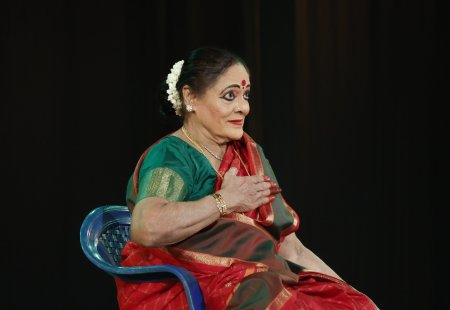 Kanaka Srinivasan Kanaka Srinivasan, Bharatanatyam specialist of Vazhuvoor vintage (who trained under Guru Vazhuvoor Ramaiah Pillai himself), decorated with many awards, and appreciated during her younger days for her all-round excellence with a special emphasis on depth of abhinaya, paid her personal homage through a Javali performed in bhav batana style, with vocal support by Nandini Anand and mridangam accompaniment provided by Keshavan Ramamurty. A composition of Tirupati Narayanaswamy in raga Hindustani Kapi, this interpretative item shows a nayika lamenting with her sakhi about the once deep love the Lord had for her - now alas despite her sending an urgent message, he has failed to respond, Bayarani baliche Brahma nammina rade. The dancer's mobile facial expressions made for evocative abhinaya. Balancing this expressional presentation with a Thumri presented by a Kathak dancer, would have been a wiser way of underlining the differences in the two dance forms of Bharatanatyam and Kathak, than what was embarked upon, by trying to make a comparison of technique between the two dance forms through the Margam and Nritta kram (which exercise had no time). The mention of technique with the Bharatanatyam araimandi against the straight sama pada stance in Kathak made for a start. But from this basic stance spring approaches which are very different. Kathak makes use of just a repetitive musical refrain till towards the end the abhinaya oriented Thumri or Bhajan is ushered in - where the word makes its appearance - unlike Bharatanatyam where, after Alarippu one presents the Sabdam, going on to an elaborate treatment of both nritta and abhinaya in the Varnam, before moving on to the total absorption with just the word sans rhythm, in the Padam and Javali, where manodharma counts. Unlike the very codified Bharatanatyam approach, Kathak, with more of abstract dance and preoccupation with the rhythmic syllables or bols in the tala, believes in nritta improvisation from the word go. Kanaka's student Nandini presenting an uncomplicated version of Alarippu against a basic Amad presentation by Sweta and Sambhavika, students of Lakshmi Kannan, was neither here nor there. The Kathak beginning on the stage, for me, is with Thata where the body opens out very gradually, soaking in the music of the lehera refrain - Tihai, Gat, Paran, Tatkar being just short ad-forms in pure dance, with even stopgap tatkar footwork putting the emphasis on improvisation. Dancer Sanhita Basu Ghose who has studied under gurus like Kelucharan Mohapatra and Giridhari Nayak presented Odissi. Her Krishna as visualised in Madhurashtakam, to hold audience attention, required more vibrancy - with the sameness of tone and speed over a long period, counter-pointed by rhythmic interregnums to avoid monotony, before going back to the refrain of the main composition. The second evening, the Bharatanatyam male/female couple Nideesh and Indu, from the Kalakshetra alumni, and founders of Indeesha Fine Arts and Trust, known for advocacy of social responsibility in art with themes of global concern, brought in an infectious spirit of youth and love in their presentation Rusli Radha, Rusala Madhav, Rusle Gokul Sare wherein the infectious moods of closeness and alienation between Krishna and Radha, are reflected in the whole of Gokul itself. The vocal support in Misra Yaman was melodious. The couple, students of Bragha in abhinaya, recaptured with joy, moments spent with Birju Maharaj. The Hindustani classical music interlude on the second evening, at a fairly advanced hour, after a long dance programme (with senior dancers commissioned to perform as finale yet to take the stage) was not a wise idea. Raga expansion requires a certain mood and without a proper raised platform to seat the musicians, and with sound arrangements made in a hurry, the sitar strings of Dhruvanath Misra sounded off key and with Sukhdev Misra on violin, Vivek Misra on tabla, Bholanath Misra on second tabla, the interlude in raga Charukesi fell short of expectations. Pity! 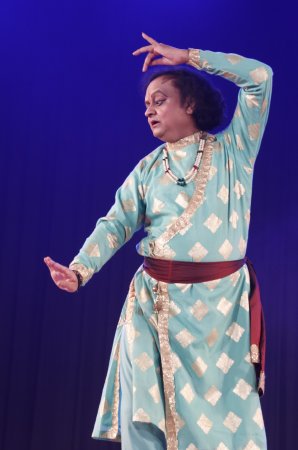 Deepak Maharaj Deepak Maharaj's solo as the concluding part of the two day festival provided a classical example of what rhythm in Kathak means. This son of Pandit Birju Maharaj has inherited that uncanny feel for fractional intervals of rhythm in a tala cycle. The upaj in teental was characterised by a clean pure sound with no smudges, and whether it was the full foot in contact with the floor, or just the front part of the feet tapping rhythm or the heel establishing floor contact with the rest of the foot uninvolved, the bullet like precision is what was special. And with improvisations flowing with ease, the tablist did not find maintaining the theka easy. Thaat with the imperceptible moves to freeze, with the Devi/Devata andaz in Thaat, Uthan, the Ginti tihais, giving an example of how Maharaji by using the same syllables or bols, suggested childhood, youth and old age in movement, were all part of Deepak Maharaj's recital. Then came the Gat bhav sequence with Maharaji's favourite makhan chor, to end with his own favourite Ladhi takita takita dhin - variations spun round this set of bols, executed with a special panache by Deepak. Unfortunately there was no thumri. He has learnt singing too and without the abhinaya element, the Maharaj's heritage is not complete. There was no time for this. For this critic, a fine part of the presentation lay in the very poised Ragini Maharaj (daughter of Deepak Maharaj) radiating confidence in her parhant, making it obvious that here is a very special talent in the family line to carry on the name. Inheritance no doubt plays a great part. But even for those who are blessed, it is important to work at and maintain the body which is your instrument, and to remember that all knowledge and art, unless given the right environment for continued growth, through healthy interaction, will stagnate. For having carried off such an ambitious event, Neha Banerjee's loyalty to the guru needs all praise.  Writing on the dance scene for the last forty years, Leela Venkataraman's incisive comments on performances of all dance forms, participation in dance discussions both in India and abroad, and as a regular contributor to Hindu Friday Review, journals like Sruti and Nartanam, makes her voice respected for its balanced critiquing. She is the author of several books like Indian Classical dance: Tradition in Transition, Classical Dance in India and Indian Classical dance: The Renaissance and Beyond. Post your comments Pl provide your name and email id along with your comment. All appropriate comments posted with name and email id in the blog will also be featured in the site. |